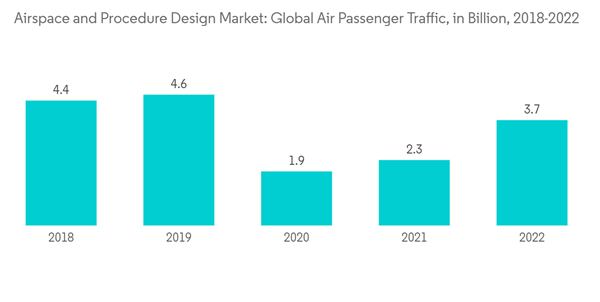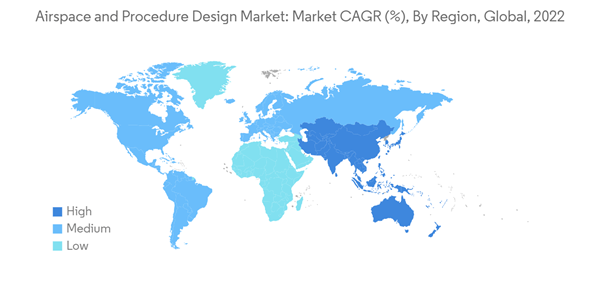Key Highlights
- According to the latest updates from the International Air Transport Association (IATA), the International Civil Aviation Organization (ICAO), the Airports Council International (ACI), the UN World Tourism Organization (UNWTO), the World Trade Organization (WTO), and the International Monetary Fund (IMF), the international air passenger traffic in 2022 improved compared to that of 2021. The international air passenger traffic during 2022 increased by 152.7% YoY, while the revenue passenger kilometers (RPK) grew by 64.4% compared to 2021 and reached around 76.9% of the December 2019 pre-pandemic levels.
- The growth in passenger traffic over the past few years has led governments and airport authorities to invest in expanding their existing airport infrastructure and constructing new airports to increase their passenger handling capacities. This is expected to drive the growth of the market during the forecast period.
- In addition to this, the airlines and airport operators also invest in the modernization of air traffic management infrastructure and automation of existing equipment, which will accelerate the market growth in the coming years.
- However, risk of cyber attack is a major threat to the growth of the airspace and procedure design market.
Airspace And Procedure Design Market Trends
Hardware Segment to Dominate Market Share During the Forecast Period
The construction of new airports and the expansion of existing airports are anticipated to generate the demand for air traffic management hardware worldwide. Several airports are replacing aging hardware equipment with new advanced equipment to enhance the efficiency of air traffic management operations. Recently, THALES announced that the company installed ATM systems at Abeid Amani Karume International Airport, Arusha Airport, Julius Nyerere International Airport, Kilimanjaro International Airport, Mwanza International Airport, and Songwe Airport. The modernization is a part of the contract between THALES and the Tanzania Civil Aviation Authority (TCAA) to enhance the country’s air traffic safety and efficiency. The company installed surveillance radars and TopSky – ATC as a part of modernization.Similarly, in April 2022, the Federal Aviation Administration announced an investment of more than USD 1 billion under the President’s Bipartisan Infrastructure Law for air traffic control tower replacement, modernization of navigation, weather and tracking equipment, upgrades to power systems, infrastructure upgrades at the air route traffic control centers, towers, and TRACONs, among others at the airport. Such developments are anticipated to drive the demand for the hardware segment rapidly during the forecast period.
Asia-Pacific To Witness Highest Growth During the Forecast Period
The Asia-Pacific region is expected to lead the market with the highest CAGR during the forecast period. The growth in the market is propelled by robust investments toward constructing new airports and expanding existing airports in China and India. In January 2022, the Civil Aviation Administration of China (CAAC) announced its plan to increase the number of civil transport airports in the country to more than 270 by 2025. The construction of new airports will allow the country to handle 17 million aircraft movements annually and increase the passenger handling and cargo handling capacities to 930 million passengers and 9.5 million tonnes, respectively, by 2025. Such developments would bolster the adoption of sophisticated air traffic management systems to ensure high levels of safety and operational efficiency in the country. In addition, a similar increase in passenger volume and adjoining demand from airline customers, as well as new air traffic management requirements and environmental regulations, are forcing Indian airports to continuously adapt and improve their infrastructure and operations. Digital transformation is reshaping the Indian airport industry through the integration of the Internet of Things (IoT)- enabled technologies to help airports optimize their operations and enable safe and timely passenger travel. In March 2022, to support the Make in India Initiative, Bharat Electronics Limited (BEL) entered into a partnership with the Airports Authority of India (AAI) to research and develop systems for air traffic management and surface movement of aircraft at airports. Such investments into the development and introduction of new ATM systems are expected to drive the growth prospects of the air traffic management market in the Asia-Pacific region during the forecast period. Airspace And Procedure Design Industry Overview
The airspace and procedure design market is semi-consolidated, with many local and international players providing various hardware, software, and services. Adacel Technologies Limited, Honeywell International Inc., Indra Sistemas SA, THALES, and Northrop Grumman Corporation are some of the prominent players in the airspace and procedure design market. Players are concentrating on the launch of secure products that can learn and improve themselves through built-in AI technology. Most software producers are using AI to improve the efficiency and speed of accessing important data on the database. For instance, Honeywell launched a new generation NAVITAS software suite platform to support the operations of airport operators and air navigation service providers. The software is integrated with artificial intelligence (AI), big data, cybersecurity, machine learning, and human-centered designs that will support and enable automation and digitization of air traffic services for efficient ground movement, enhanced situational awareness, control and monitoring of airside, information management, and integration. International players are expected to benefit from the partnership with local producers of airspace and procedure design systems, parts, and components and third-party software manufacturers of systems. Such initiatives of the companies are expected to help them increase their geographic presence in the years to come.
Additional Benefits:
- The market estimate (ME) sheet in Excel format
- 3 months of analyst support
This product will be delivered within 2 business days.










